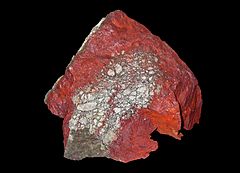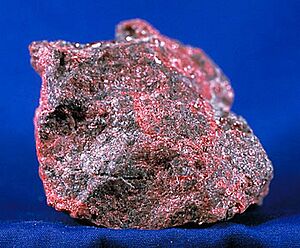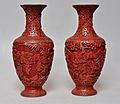Cinnabar facts for kids
Quick facts for kids Cinnabar |
|
|---|---|

Cinnabar
|
|
| General | |
| Category | Sulfide mineral |
| Formula (repeating unit) |
Mercury(II) sulfide, HgS |
| Strunz classification | 2.CD.15a |
| Crystal symmetry | P3121, P3221 |
| Unit cell | a = 4.145(2) Å, c = 9.496(2) Å, Z = 3 |
| Identification | |
| Color | Cochineal-red, towards brownish red and lead-gray |
| Crystal habit | Rhombohedral to tabular; granular to massive and as incrustations |
| Crystal system | Trigonal |
| Twinning | Simple contact twins, twin plane {0001} |
| Cleavage | Prismatic {1010}, perfect |
| Fracture | Uneven to subconchoidal |
| Tenacity | Slightly sectile |
| Mohs scale hardness | 2.0-2.5 |
| Luster | Adamantine to dull |
| Streak | Scarlet |
| Diaphaneity | Transparent in thin pieces |
| Specific gravity | 8.176 |
| Optical properties | Uniaxial (+) |
| Refractive index | nω = 2.905 nε = 3.256 |
| Birefringence | δ = 0.351 |
| Solubility | 1.04 x 10−25 g per 100 ml water (Ksp at 25°C = 2 x 10−32) |
Cinnabar is a bright scarlet to brick-red mineral. It is the most common natural source of mercury metal. For a long time, Cinnabar was also used to make a famous red paint called vermilion.
You can often find Cinnabar near places with recent volcanic activity and hot springs. It forms in cracks in rocks.
People have used Cinnabar for its amazing red color for thousands of years. Ancient cultures in the Near East used it as a cosmetic, like rouge. The Olmec culture in the New World also used it. In China, during the Song Dynasty, it was used to color beautiful lacquerware.
It's important to know that Cinnabar contains mercury, which can be harmful. People in ancient Rome already knew about the dangers of mercury.
Even today, Cinnabar is still forming. You can see this happening at places like the Sulphur Bank Mine in California and Steamboat Springs, Nevada. People have been mining Cinnabar since the Neolithic age.
Contents
Getting Mercury from Cinnabar
Cinnabar is the main natural source of mercury. People have mined it for thousands of years. Even in the time of the Roman Empire, it was mined for its red color and for the mercury it contained.
To get liquid mercury, also called quicksilver, Cinnabar ore is crushed. Then, it is heated in special ovens called rotary furnaces. When heated, the mercury separates from the sulfur and turns into a gas. This gas is then cooled down in a condensing column. As it cools, it turns back into liquid mercury. This liquid metal is usually stored and shipped in strong iron containers.
Safety with Cinnabar
Cinnabar contains mercury, which can be harmful to people. Even in ancient Rome, people knew about the dangers of mercury.
Working with Cinnabar or processing it into mercury could be very dangerous. Miners and workers often suffered from health problems. These problems included shaking, losing their senses, and even death. In ancient Rome, working in mercury mines was seen as a very risky job. For example, mining in the Spanish Cinnabar mines of Almadén was considered almost a death sentence. This was because the miners, who were often slaves or prisoners, had much shorter lives.
Cinnabar in Art and Decoration
Cinnabar's bright red color has been used in art for a very long time. In the Near East, people used it as a cosmetic. In the New World, the Olmec culture used it.
One amazing example is from the Maya civilization. In the Tomb of the Red Queen in Palenque (around 600–700 AD), a noble woman's remains and her belongings were completely covered in bright red Cinnabar powder. This shows how important its color was.
Cinnabar is also famous for its use in Chinese carved lacquerware. This art form started in the Song Dynasty. In these artworks, the powdered Cinnabar pigment was mixed into lacquer. This helped to reduce the danger of mercury poisoning. However, if these old pieces were broken, the mercury could still become an environmental hazard. Today, in jewelry, a safe, resin-based material is used instead of Cinnabar. It looks similar but doesn't have the dangerous mercury.
Images for kids
-
Cinnabar mercury ore from Nevada, United States
-
Chinese carved cinnabar lacquerware, late Qing dynasty. Adilnor Collection, Sweden.
See also
 In Spanish: Cinabrio para niños
In Spanish: Cinabrio para niños




